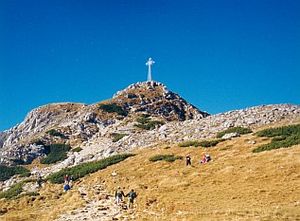Giewont
| Giewont | ||
|---|---|---|
|
Giewont seen from Zakopane (north) |
||
| height | 1895 m npm | |
| location | Poland , Lesser Poland Voivodeship | |
| Mountains | Western Tatras , Tatra Mountains | |
| Coordinates | 49 ° 15 '3 " N , 19 ° 55' 59" E | |
|
|
||



The Giewont is a mountain range with its highest peak in the Wielki Giewont at 1,895 meters above sea level near Zakopane in the Polish West Tatras . From the top there is a panoramic view of Zakopane and the Tatra Mountains . It is one of the four local mountains of Zakopane and one of the most popular excursion destinations in the Tatra Mountains.
Location and surroundings
Below the summit lie the Dolina Bystrej , Dolina Kondratowa , Dolina Małej Łąki and Dolina Strążyska valleys . It is particularly easy to see from Zakopane thanks to its sloping, six hundred meter high north face. To the east of the summit is the Szczerba mountain pass .
The 2.7 km long ridge of the massif runs from west to east as follows:
- Summit Mały Giewont - 1728 m npm
- Giewoncka Przełęcz mountain pass - 1680 m npm
- Wielki Giewont summit - 1894 m npm
- Szczerba mountain pass - 1823 m npm
- Summit Długi Giewont - 1867 m npm
geology
The massif consists mainly of sedimentary rock , especially limestone and dolomites from the geological ages of the Triassic , Jurassic and Cretaceous .
etymology
The oldest sources refer to the massif as Gyewant . The origin of the name is not clearly established. According to one opinion, the name comes from the name of the Góralen family Giewonty . According to another view, it is of German origin and comes from the word wall ( garment or Gähwand ), as an allusion to the 600 meter high north wall.
history
From the 16th century copper was mined in the massif. Numerous legends arose about the mountain range in the 18th century. He is said to represent a sleeping knight who will restore Poland's independence after the partition of Poland . After a modification of the legend in its numerous caves (should Jaskinia Zawaliskowa w długim Giewoncie , w Studnia Giewoncie , Jaskinia Juhaska , Jaskinia Śpiących Rycerzy , Jaskinia Śpiących Rycerzy Wyżnia , Kozia Grota , Dziura w Szczerbie , Ruda Nyża , Dziura nad Dolina Strążyska ) Ritter sleep . Since the 19th century, the north face has been a popular destination for climbers who have created numerous via ferratas in the wall. The Tatra National Park has designated the north face as a strictly protected nature reserve and is now closed to climbers. Walery Eljasz-Radzikowski named Giewont King of Zakopane in 1880 . A 17-meter-high iron cross was erected on the summit at the turn of the last century.
First ascent
The peaks have been visited by shepherds and hunters since the late Middle Ages. The first proven rise was made in 1830 by Franciszek Herbich and Aleksander Zawadzki . The first winter ascent was made by Mariusz Zaruski in 1904.
Flora and fauna
The tree line is around 1500 meters. The Giewont is a retreat for bears, chamois and marmots. Its north face is a strictly protected nature reserve. It has been part of the Tatra National Park since 1954 .
tourism
The Giewont is popular with hikers. The summit area towers about 1100 meters above the center of Zakopane. The ascent from the south over the Kondracka Przełęcz mountain pass is significantly easier than the ascent from the north. The chain-secured ascent and descent from the mountain pass is designed as a one-way route to improve the safety of hikers.
Routes to the summit
Hiking trails lead to the main summit.
- ▬ A blue hiking trail leads fromthe Kuźnice districtof Zakopane over the Kondracka Przełęcz mountain passto the summit.
- ▬ A red marked hiking trail leads from the Dolina Strążyska valleyover the Kondracka Przełęcz mountain passto the summit.
- ▬ A yellow hiking trail leads from the Kościelisko district of Gronik over the Kondracka Przełęcz mountain passto the summit.
The Kondratowa Hut , Ornak Hut and the Kalatówki Mountain Hotel are ideal starting points for an ascent from the valleys .
Web links
supporting documents
- Zofia Radwańska-Paryska, Witold Henryk Paryski, Wielka encyklopedia tatrzańska, Poronin, Wyd. Górskie, 2004, ISBN 83-7104-009-1 .
- Tatry Wysokie słowackie i polskie. Mapa turystyczna 1: 25.000, Warszawa, 2005/06, Polkart, ISBN 83-87873-26-8 .
panorama


